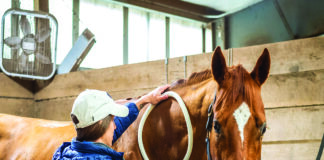Many horse owners watch their horses nibble away at grass and hay, knowing that they’re also ingesting a certain amount of sand with each mouthful. Dry, gritty soil can eventually lead to sand colic, as the horse ingests a tiny amount of grit with each meal. Although the natural motility of a horse’s gut will rid the digestive tract of much of the sand, damage can occur if a horse continuously ingests sand. As the abrasive sand irritates the lining of the intestine, the horse may develop diarrhea and lose weight. If enough sand builds up in the horse’s gut, an impaction can form causing colic, and that’s a veterinary emergency.
Of course, the best solution is prevention. If a horse is stabled or pastured on sandy soil, feed should be placed on rubber mats. In many instances, the mats will require daily sweeping to keep them free of loose sand. Another tactic is to feed psyllium on repeated, regular schedules according to a vet’s recommendations.
How does psyllium work? The powdery fiber is the husk of the fleawort seed and is a popular laxative for people. When moistened in the digestive tract, it becomes a gelatinous substance. When fed to horses, psyllium absorbs water in the gut and becomes gel-like, helping to push sand out of the digestive tract. Because it’s dry and tasteless, you’ll have to coax most horses into consuming psyllium. Never wet psyllium as that will make it a gooey mess. Instead, mix it with a ration of pellets or grain and drizzle vegetable oil on top of the feed. Stir to mix it all together and the horse won’t even notice the psyllium dressing.






Well, my horse doesn’t eat sand but he loves mud and dirt.
I give my horses beet pulp to help getting any sand out.
Our vet said not to include ANY oil when feeding Psyllium because it needs water to work and the oil doesn’t mix with the water and will render the psyllium ineffective.
Psyllium definitely works for treatment. I use that and I feed on a tarp to help minimize the amount of dirt consumption. Works really well@
the roughage of hay helps to clear sand as well.
Interesting!